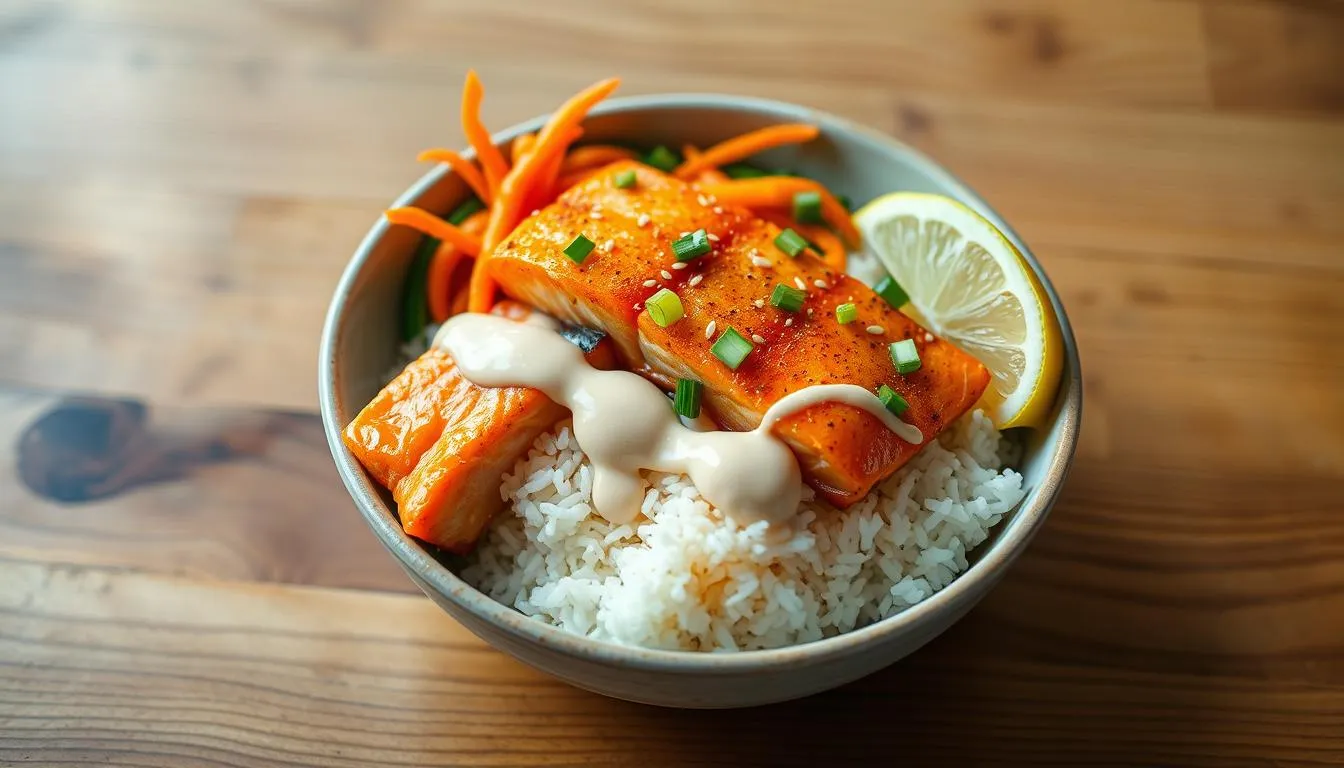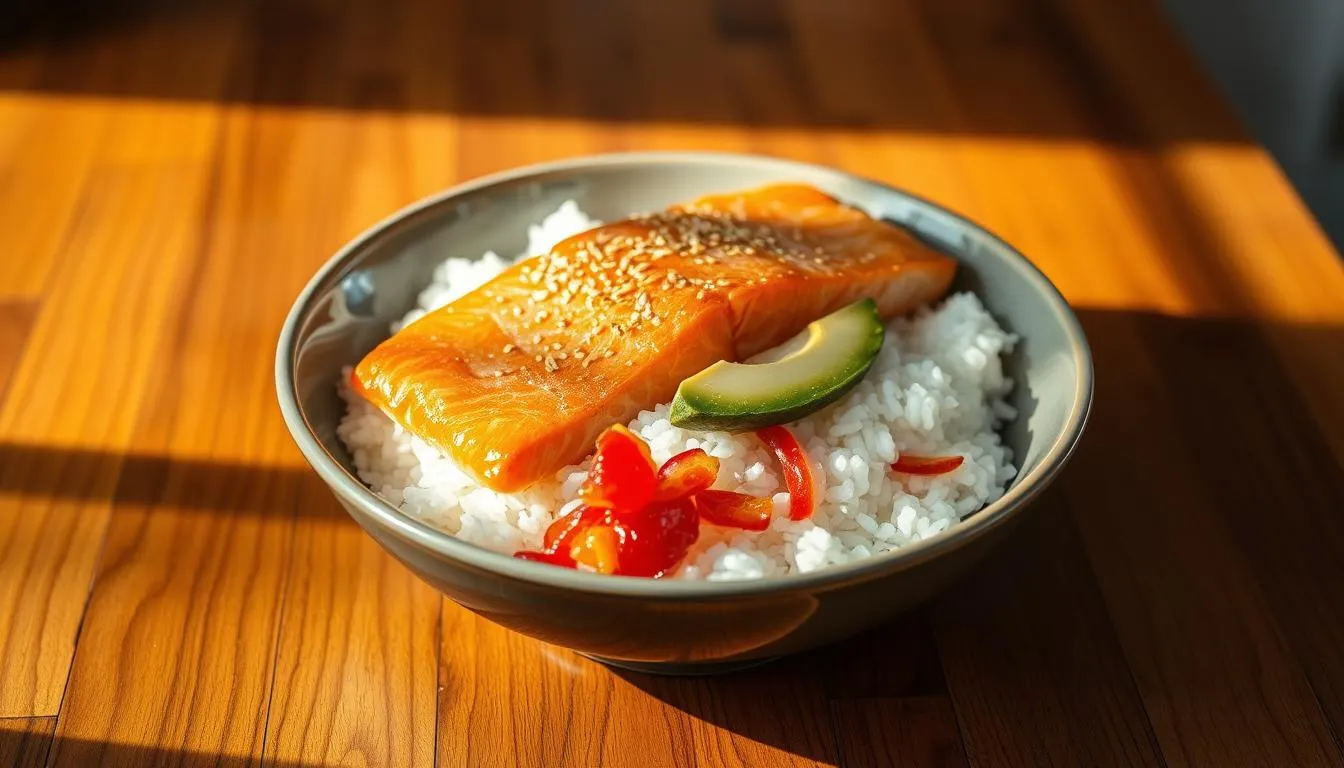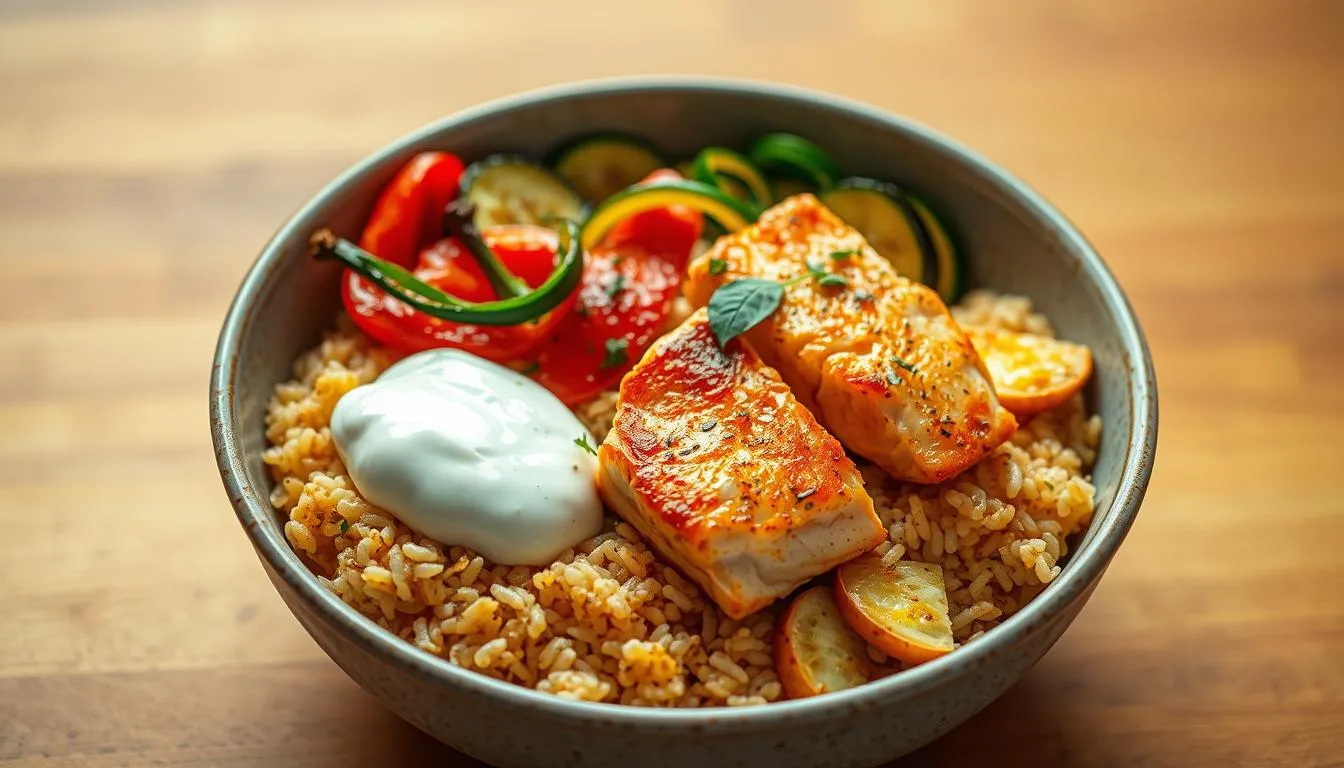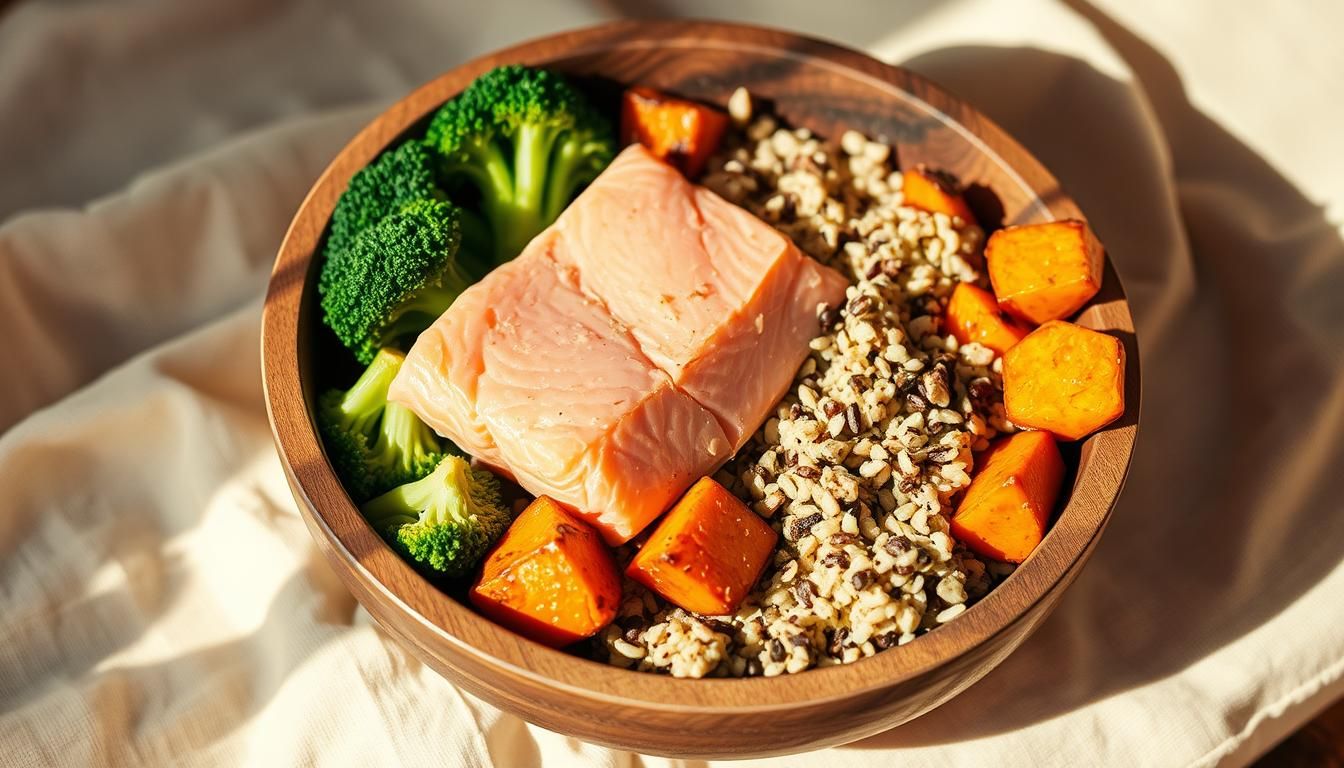Some nights I walk in hungry and tired, holding a container of rice and a piece of cooked fish that feels like a promise. I want comfort that’s fast and real. This guide is for that exact moment.
Think of a quick rice bowl that tastes fresh, not reheated. We’ll show a simple salmon rice bowl method that turns plain ingredients into a craveable dinner in minutes. Small swaps—avocado, kimchi, roasted seaweed—lift texture and color. If you need fresh salmon recipes to start with, check out our guide to simple and delicious salmon recipes.
The approach here is practical. Use about 4 oz cooked salmon with roughly 3/4 cup rice for a balanced portion. We focus on easy reheating, smart oil and seasoning tips, and pantry-friendly ingredients that keep protein front and center.
Key Takeaways
- Transform simple rice and cooked salmon into a fast, satisfying dinner.
- Use modest portions—about 4 oz fish with 3/4 cup rice—for balance and protein.
- Top with avocado, kimchi, or seaweed for contrast and crunch.
- Quick reheating and small oil or seasoning tweaks keep texture tender.
- This method is weeknight-friendly and relies on pantry staples and fresh touches.
Why this quick salmon rice bowl is still worth the hype
One clever microwave trick changed how home cooks revive refrigerated rice and cooked fish.
The method fixes a common problem: cold rice gets dry and clumpy, but placing a single ice cube under parchment paper while microwaving gently steams grains back to life. This small step makes rice soft without sogginess.
Emily Mariko’s viral reel showed how flaked salmon on cold rice, a sheet of parchment, and that ice cube turn simple ingredients into a satisfying dinner. Finish it with soy sauce, kewpie mayo, and sriracha for instant umami, creaminess, and heat.
 The appeal goes beyond speed. Whether you use white or brown rice, this rice bowl feels restaurant-level with minimal cleanup. Add avocado, kimchi, and crispy seaweed for texture and contrast. It’s a flexible recipe you can tweak—more soy here, extra mayo there—while keeping the signature flavor intact.
The appeal goes beyond speed. Whether you use white or brown rice, this rice bowl feels restaurant-level with minimal cleanup. Add avocado, kimchi, and crispy seaweed for texture and contrast. It’s a flexible recipe you can tweak—more soy here, extra mayo there—while keeping the signature flavor intact.
- Steam-revive cold rice with an ice cube + parchment paper.
- Combine soy sauce, kewpie mayo, and sriracha for a fast sauce.
- Top with avocado, kimchi, and roasted seaweed to scoop and enjoy.
| Step | What to use | Why it works |
|---|---|---|
| Prep rice | Refrigerated rice, ice cube, parchment | Steam restores moisture and fluff |
| Warm salmon | Flaked fish, short microwave burst | Keeps texture tender without overcooking |
| Finish | Soy sauce, kewpie mayo, sriracha, avocado, seaweed | Balance of umami, cream, heat, and crunch |
Leftover salmon bowl
This quick method revives refrigerated rice and cooked fish so you get a fresh-tasting meal in minutes.
Essential ingredients
Gather: rice, cooked salmon, soy sauce, kewpie mayo, and sriracha. Add avocado, roasted seaweed, and kimchi to finish.
Viral method, step-by-step
Flake the cooked salmon with a fork on a plate. Spread cold rice over the fish. Tuck one ice cube into the rice, then cover with parchment paper.
Microwave on high for about 1–2.5 minutes until everything is hot and steamy. Remove any remaining ice, then break up the mix and stir.
Toppings to finish
Dress with soy sauce, a ribbon of kewpie mayo, and a squeeze of sriracha. Top with diced avocado, kimchi, and roasted seaweed for contrast.
From fridge to table in minutes
Heat in short bursts so the fish stays tender. The ice cube plus parchment paper steams the rice without drying it.
If you don’t have cooked salmon, air fry a fillet at 390°F for 7–9 minutes or bake at 400°F for 8–10 minutes, then flake and follow the same steps.
 - Use a fork to flake for even warming.
- Use a fork to flake for even warming.
- Microwave with an ice cube and parchment to rehydrate rice.
- Mix sauces well, then top and serve immediately.
Mediterranean-style salmon bowls with crispy rice
Give day-old rice a Mediterranean makeover by crisping it in a hot pan until golden.
How to make crispy rice: Toss cooled basmati or brown rice with a spoonful of Greek yogurt and a touch of ghee so grains cling. Heat extra virgin olive oil in a wide nonstick skillet, spread the rice in a single layer, and let it fry undisturbed until golden. Stir occasionally; total crisping takes about 10–15 minutes.

Quickly season and pan-sear the fish
Cut the fish into 1-inch pieces and season with lemon zest, a pinch of dried oregano, garlic powder, and Aleppo pepper. Heat EVOO until shimmering and sear the cubes 4–7 minutes, turning once so edges crisp while the center stays flaky.
Bright toppings to add
Layer on sliced bell peppers, chopped green onion, fresh parsley or cilantro, sun-dried tomatoes, and crumbled feta. These fresh toppers bring crunch, tang, and cream to the plate.
Assemble: crunchy, creamy, fresh
Divide the crispy rice, arrange the seared pieces on top, and finish with a drizzle of green tahini, tzatziki, or a lemony ladolemono. A final squeeze of lemon brightens the dish and helps to top salmon perfectly.
For a full Mediterranean salmon rice bowl recipe and more tips, see a detailed version here.
Flavor paths: easy salmon rice bowl combinations to try
A few targeted sauces and toppings let one base become five distinct dinners. Below are simple combos that transform rice and cooked fish into something new and satisfying.
Classic Emily-inspired
Mix soy sauce, kewpie mayo, and sriracha through hot salmon rice, then top with ripe avocado. Scoop bites with roasted seaweed for extra crunch.
Spicy kimchi crunch
Fold chopped kimchi into the rice for tang and heat. Add extra sriracha and a light drizzle of mayo to balance the bite.
Mediterranean fresh
Use a tahini-herb sauce with bell peppers, sun-dried tomatoes, and crumbled feta. This bright, savory combo turns a rice bowl into a Mediterranean-style recipe.
Light and bright
Choose lemony ladolemono, fresh herbs, and crunchy cucumber to keep the fish forward and the bowl refreshing.
High-protein add-on
Top with a fried egg so the runny yolk becomes an instant sauce that amps up protein without stealing the spotlight.
- Fan avocado slices on top salmon for cool creaminess.
- Start with modest sauce, taste, then add more to keep balance.
- Seaweed on the side makes each rice bowl bite layered and fun.
Sauces and sides that make your bowl pop
A smart sauce and the right sides lift simple rice and cooked fish into something memorable. These finishing touches make a salmon rice bowl feel intentional, not thrown together.
Creamy sauce options
Kewpie mayo gives silky richness that clings to rice and salmon. Use a thin ribbon so it doesn’t overwhelm the other ingredients.
For a Mediterranean tilt, try green tahini or tzatziki. Both add herbaceous lift and balance salty sauces.
Umami and heat
Mix soy sauce with a little sriracha for instant umami and kick. Start with small amounts, taste, and build until the rice hits your sweet spot.
For a glossy finish, whisk a splash of soy into mayo and drizzle over the top for a patterned sauce that looks as good as it tastes.
Crunchy wraps and scoops
Roasted Korean seaweed snacks are perfect for scooping salmon rice. Their light crisp texture and salty pop make every bite fun.
Add a small side of kimchi or a few slices of avocado to cut richness and add brightness. Keep sauces in a dish so you can drizzle to order.
- Mayo acts as a binder for cohesive bites.
- Seaweed snacks double as crunchy wraps and a salty contrast.
- Keep a clean tasting spoon or small dish to test sauce balance before you pour.
Pro tips to make salmon rice fast, fluffy, and flavorful
Use a few simple habits to keep texture and taste strong when you reheat or rework cooked fish and rice.
Rice rehab: why the ice cube and parchment paper trick works
Steam restores moisture. Nest an ice cube under parchment paper over cold rice and heat briefly in the microwave. The trapped steam softens grains without sogginess.
Brown rice, basmati, or day-old white — what to use and when
All three work. Choose brown rice for chew, basmati for fragrance, and day-old white for quick crisping in a pan.
Smart salmon: flake with a fork and avoid over-reheating
Gently use a fork to flake so heat spreads evenly. Warm in short bursts to keep the fish tender and moist.
Time-savers: air fryer or canned protein in a pinch
Air fry at 390°F for 7–9 minutes or bake at 400°F for 8–10 minutes, then flake. Canned salmon is a fast swap—drain, season, and fold into hot rice with a splash of soy sauce.
| Method | Time | Best use |
|---|---|---|
| Microwave + ice cube | 1–2.5 minutes | Quick reheat, soft rice |
| Air fryer | 7–9 minutes at 390°F | Fresh-cooked texture |
| Oven | 8–10 minutes at 400°F | Even cooking for thicker fillets |
| Canned | Ready in 1 minute | Fast protein swap for busy nights |
- Add a teaspoon of oil if rice seems dry before heating.
- Season lightly, taste, then finish with soy sauce.
- Assemble on a plate or shallow rice bowl so mixing is easy and every bite stays fluffy.
Ingredient swaps and dietary notes
Simple ingredient switches let you control heat, salt, and allergens while keeping fast prep.
If you avoid soy, try coconut aminos. It brings a similar sweet-savory note that suits a salmon rice bowl without the wheat. For gluten-free, choose certified tamari or coconut aminos and check labels on bottled sauces.
Don’t have kewpie mayo? Whisk light mayo with a splash of rice vinegar and a pinch of sugar to mimic its tang and sweetness. Use that homemade mayo as a ribboned sauce for rice and fish.
Dairy-free swaps work well. Skip Greek yogurt and feta, use green tahini or extra olive oil, and add sliced avocado for cream. Brown rice is a hearty, higher-fiber base; use it day-old so it crisps or reheats with steam and stays fluffy.
“Start small with spice and taste as you go.”
- Tailor heat with more or less sriracha, mild chili flakes, or kimchi on the side.
- Keep seasonings simple when swapping ingredients to protect the core recipe balance.
Make-ahead, storage, and reheating
Pack ingredients so each element keeps its best texture until it’s time to eat. Store rice, protein, and toppings in separate airtight containers for the cleanest results.
Store components separately for best texture
Keep sauces in small jars. Crisp items such as seaweed or chips should stay sealed at room temperature until serving.
Reheat rice and veggies; add salmon last to keep it tender
Warm rice and sautéed vegetables first—stovetop over medium heat works well. A splash of water and a lid or an ice cube under parchment paper in the microwave helps rehydrate cold rice in minutes.
Flake the leftover cooked salmon with a fork and add it on top of the hot rice. The gentle residual heat warms the fish without drying it.
“Store separately, reheat smart, and add the fish last for best texture.”
- Brown rice reheats well with steam; add a teaspoon of oil for sheen.
- For crisp veggies, sear briefly in an oiled pan to revive color and snap.
- Assemble on a plate or shallow rice bowl so you can mix evenly and serve right away.
Conclusion
With a few pantry staples and one simple steam trick, you can make a reliable salmon rice bowl that feels fresh and fast.
The steam-and-mix method keeps rice fluffy and salmon tender, and a quick ribbon of mayo, a splash of soy sauce, and a hit of sriracha deliver instant flavor.
Keep avocado, roasted seaweed, and kimchi on hand to top each bowl for cream, crunch, and tang. When you want variety, try a Mediterranean twist with crispy rice and lemon-herb fish.
If you don’t have pre-cooked fish, air fry or bake and then make salmon rice the same way. This recipe gets dinner on the table in minutes and is easy to tweak as your tastes change—save it among your weeknight recipes and enjoy.
FAQ
How do I quickly revive cold cooked salmon and rice so they taste fresh?
Gently reheat rice with a splash of water and a folded piece of parchment paper over the dish in the microwave for 30–60 seconds to steam it fluffy. For the fish, warm it briefly — 20–30 seconds — under a damp paper towel or in a low oven (300°F) until just heated through to avoid drying. Finish with a squeeze of lemon or a drizzle of kewpie mayo mixed with sriracha for moisture and flavor.
Can I use brown rice or other grains instead of white rice?
Yes. Brown rice, basmati, or even quinoa work well. Brown rice takes longer to reheat fully, so add a little extra moisture and heat a bit longer. Choose the grain that matches your texture preference and reheating time.
What is the ice-cube-and-parchment trick I’ve heard about?
Place an ice cube on top of flaked cooked fish or a small pile of rice, cover with parchment, and microwave briefly. The melting ice creates steam that warms food evenly and helps prevent hotspots and drying. Use short bursts and check often.
Is it safe to reheat fish in the microwave?
Yes, if you reheat gently and don’t overcook. Use low power or short intervals, cover to retain moisture, and stop as soon as it’s warm. Overheating makes protein dry and chalky, so less is more.
What quick sauces make a simple rice and fish bowl taste restaurant-level?
Classic combos include kewpie mayo with sriracha, soy sauce mixed with sesame oil and scallions, or a tahini-herb dressing for a Mediterranean twist. These add fat, umami, and brightness without much prep.
Which toppings give the best texture contrast?
Add creamy avocado, crunchy roasted seaweed snacks, and tangy kimchi or quick-pickled cucumbers. A fried egg or toasted sesame seeds also adds richness and crunch for balance.
How should I store the components to keep everything tasting good later?
Store rice, cooked fish, and wet toppings like kimchi separately in airtight containers. Keep creamy sauces in small jars and add them just before serving to preserve texture. Consume within 2–3 days for best quality.
What are fast protein-friendly swaps if I don’t have cooked fish?
Canned fish, rotisserie chicken, or a quick pan-seared fillet work as fast alternatives. Canned options are already cooked and reheat quickly; just drain and season before topping the grain.
How can I make a crispy rice base like a Mediterranean-style bowl?
Use day-old rice, press it into a hot oiled skillet with a little ghee or extra-virgin olive oil, and cook without stirring until the bottom crisps. Flip or press into patties for even texture. Top with herbs, feta, and lemon.
Any tips to keep the fish moist when pan-searing or reheating in an air fryer?
For pan-searing, pat the fillet dry, season, and sear skin-side down in hot oil until crisp, then finish in a moderate oven briefly. For air fryer reheating, use a light spray of oil and lower temperature (around 320°F) for a short time to warm without drying out.
What substitutions work for soy sauce for low-sodium or gluten-free diets?
Use tamari for a gluten-free option and reduced-sodium tamari or coconut aminos for lower sodium. Adjust quantity to taste, since coconut aminos are slightly sweeter and less salty.
How do I assemble a balanced bowl quickly for dinner?
Start with warm grain, add a protein layer, spoon on sauce, then finish with bold toppings: fresh herbs, a creamy element like kewpie mayo or tzatziki, and a crunchy garnish. This gives contrast in flavor, texture, and nutrition in minutes.
